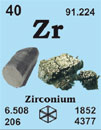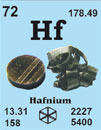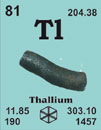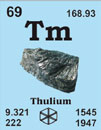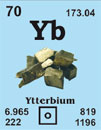Nickel 28Ni58.71
Discovered in 1751 by A.F. Cronstedt at Stockholm, Sweden.
[German, comes from kupfernickel meaning either Devil's copper or St. Nichola's copper]
French: nickel
German: nickel
Italian: nichel
Spanish: niquel
Description: Nickel is a silvery-white, lustrous, malleable and ductile metal. it resists corrosion, but is soluble in acids (exept HNO3), yet unaffected by alkalis. It is used in alloys, especially stainless steel, in coins, metal plating, and catalysts.
Nickel single crystal properties
| State: |
single crystal |
|---|
| Crystal structure: |
fcc |
|---|
| Production method: |
Czochralski |
|---|
| Standard size: |
diameter 10-20mm
thickness 1-2mm |
|---|
| Orientation: |
(100), (110) and (111) |
|---|
| Orientation accuracy: |
<2°, <1°, <0.4° or <0.1° |
|---|
| Polishing: |
as cut, one or two sides polished |
|---|
| Roughness of surface: |
<0.03µm |
|---|
| Purity: |
99.99% |
|---|
| Typical analysis (ppm): |
C 3
H < 1
O 9
N < 5
Cu 1.60
Fe 1.80
Ni < 1
Pb 0.30
Si 0.30
Ga, Hf and Ta are below the detection limit
|
|---|
Materials properties
| Density: |
8.9 g/cm3 |
|---|
| Melting point: |
1452.85 °C / 1726 °K |
|---|
| Boiling point: |
2731.85 °C / 3005 °K |
|---|
| Molar volume: |
6.59 cm3 |
|---|
| Thermal conductivity: |
90.7 [300 K] Wm-1K-1 |
|---|
| Coefficient of linear thermal expansion: |
13.3 x 10-6 K-1 |
|---|
| Electrical resistivity: |
6.84x 10-8 [293 K] Wm |
|---|
| Mass magnetic susceptibility: |
ferromagnetic |
|---|
| Young's modulus: |
199.5 GPa |
|---|
| Rigidity modulus: |
76.0 GPa |
|---|
| Bulk modulus: |
177.3 GPa |
|---|
| Poisson's ratio: |
0.312 |
|---|
| Radii: |
Ni3+ 62; Ni2+ 78; atomic 125; covalent 115 |
|---|
| Electronegativity: |
1.91 (Pauling); 1.75 (Allred); 4.40 eV (absolute) |
|---|
| Effective nuclear charge: |
4.05 (Slater); 5.71 (Clementi); 7.86 (Froese-Fischer) |
|---|
| Number of Isotopes (incl. nuclear isomers): |
14 |
|---|
| Issotope mass range: |
53 -> 67 |
|---|
| Crystal structure, (cell dimentions / pm), space group |
fcc |
|---|
| X-ray diffraction: mass absorption coefficients: |
CuKα 45.7 (µ/r) / cm2g-1
MoKα 46.6 (µ/r) / cm2g-1 |
|---|
| Neutron scattering length: |
1.03 b/10-12 cm |
|---|
| Thermal neutron capture cross-section: |
4.49 sa / barns |
|---|
Biological data
| Biological role: |
Essential to some species, and can act to stimulate metabolism. |
|---|
| Toxicity |
|
|---|
| Toxic intake: |
1 - 3 mg kg-1 |
|---|
| Lethal intake: |
LD50 (acetate, oral, rat)= 350 mg kg-1 |
|---|
| Hazards: |
Nickel and many of its compounds are poisonous, carcinogenic and teratogenic. Nickel carbonyl is extremely tzoxic. |
|---|
| Level in humans |
|
|---|
| Blood: |
0.01 - 0.05 mg dm-3 |
|---|
| Bone: |
<0.7 p.p.m. |
|---|
| Liver: |
0.02 - 1.8 p.p.m. |
|---|
| Muscle: |
1 - 2 p.p.m. |
|---|
| Daily dietary intake: |
0.3 - 0.5 mg |
|---|
| Total mass of element in average [70 kg] person: |
< 15 mg |
|---|
Geological data
| Mineral | Formula | Density | Hardness | Crystal apperance |
|---|
| Garnierite |
(Ni, Mg)6Si4O10(OH)8 |
2.3 - 2.5 |
2 - 4 |
mon., aggregates, bright green |
|---|
| Nickeline |
b-NiS |
5.27 |
3 - 3.5 |
hex., met. copper-red |
|---|
| Pentlandite |
(Ni, Fe)9S8 |
4.8 |
3.5 - 4 |
cub., met., bronze-yellow |
|---|
| Chief ore: |
garnierite, pentlandite (nickeline is rare but was the first mineral from which nickel was extracted |
|---|
| World production: |
510 000 tonnes/year |
|---|
| Main mining areas: |
garnierite in Russia, South Africa, USA; pentlandite in Cananda, South Africa |
|---|
| Reserves: |
70 x 106 tonnes |
|---|
| Specimen: |
available as foil, powder, rod, slugs, spheres and wire. Safe. |
|---|
| Abundances |
|
|---|
| Sun: |
1.91 x 106 (relative to H = 1 x 1012) |
|---|
| Earth's crust: |
c. 80 p.p.m. |
|---|
| Seawater: |
|
|---|
| Residence time: |
|
|---|
| Classification: |
recycled |
|---|
| Oxidation state: |
II |
|---|
Source: Emsley, J. (1998) The Elements (3rd Edition)

 English
English
 Deutsch
Deutsch








































